THE EFFECT OF THE SELF-SUPERVISION MODEL INTEGRATING AUTHENTIC MOVEMENT AND EPIMOTORICS' ON SELF-EFFICACY AMONG DANCE MOVEMENT THERAPISTS
DOI:
https://doi.org/10.24193/subbeag.62(4).29Keywords:
Dance/movement therapy, movement analysis, Self-Efficacy, supervision, Epimotorics’.Abstract
Introduction: This study is part of a larger research study examining the effect of a unique model of self-supervision based on Authentic Movement and Epimotorics’ on young therapists. It relies on one of the basic assumptions in dance/movement therapy – that psychological/emotional states are reflected in one’s manner of movement and body positions, and also that the position and movement of the body influence a person’s emotional/ psychological state (Shahar-Levy, 2004; Chaiklin, 2009). This study attempted to demonstrate that the unique self-supervision model would change the sense of self-efficacy of young dance/movement therapists. Supervision in this field bases itself on moving between verbal language and body-movement language, and uses both languages as a source for cognitive and psycho-emotional language knowledge (Payne, 1992; Shalem-Zafari, 2016). Methods and Materials: This study utilized film-recordings for observation, the Epimotoric’s movement-analysis tool, and questionnaires: Epimotorics’ is a method of movement observation and analysis, which relates to visible human movement as “telling” the internal psycho-emotional scenario. The self-efficacy questionnaires that were used provide information about the way the therapists’ view their own effectiveness and abilities. Results: It was found that the self-supervision model stimulated changes in the movement measures of the participants and showed marginally significant positive change in their self-efficacy. Conclusion: It can be suggested that the self-supervision model combining verbal and non-verbal movement languages allows for the use of knowledge stored in the body in combination with cognitive, verbal language. As such, it improves the therapists’ experience in relation to their sense of professional capability.References
Bandura, A. (1991). Self-efficacy mechanism in physiological activation and health-promoting behavior. In J. Madden, IV (Ed.), Neurobiology of learning, emotion and affect (pp. 229- 270). New York: Raven.
Chaiklin, S. (2009). We dance from the moment our feet touch the Earth. In S. Chaiklin &H. Wengrower (Eds.), The art and science of dance/movement therapy: Life is Dance (pp.3–12). New York, NY: Routledge.
Davis M. (1982). Body Movement and Nonverbal Communication: An annotated bibliography. 1971-1980. Bloomington: Indiana University Press.
Federman. D.J. (2011) Kinaesthetic change in the professional development of Dance Movement Therapy trainees. Body, Movement and Dance in Psychotherapy, 6(3), 195-214.
Feniger-Schaal, R., & Lotan, N. (2017). The embodiment of attachment: Directional and shaping movements in adults’ mirror game. The Arts in Psychotherapy, 53, 55-63.
Hartley, L. (2004). Somatic psychology. Body, mind and meaning. London: Whurr Publishers.
Kestenberg, J. (1975). Children and Parents: Psychoanalytic Studies in Development. New York: Jason Aronson.
Kleinfeld (2013). The connection between revealed sense of self-worth and hidden sense of self-worth, and movement: Faculty of Social Welfare & Health Sciences, Graduate School of Creative Arts Therapies (2)0.
Kołoło, H., Guszkowska, M., Mazur, J., & Dzielska, A. (2012). Self-Efficacy, self-esteem and body image as psychological determinants of 15-year-old adolescents’ physical activity levels. Human Movement, 13(3), 264-270.
Laban, R. (1974). The Language of Movement: A Guidebook to Choreutics. Boston: Plays.
Payne, H. (1992). Introduction to dance movement therapy. In H. Payne (Ed.), Dance movement therapy: Theory and practice. London: Routledge.
Shahar-Levy, Y. (2004). MeHaguf Hagalui Lesipur Hanefesh Hasamui [From the revealed body to the hidden story of the soul] 2nd ed. Printiv: Jerusalem, Israel.
Shahar-Levy, Y. (2009). Emotorics: A psychomotor model for the analysis and interpretation of emotive motor behaviour. In S. Chaiklin & H. Wengrower (Eds.), The art and science of dance/movement therapy: Life is dance (pp. 265–298). New York, NY: Routledge.
Shahar-Levy, Y. (2017). Emotorica: Paradigma gufanit-tnuatit-nafshit le-heker hatnua harigshit [Emotorics: A body-movement-mind paradigm for studying emotional movement]. http://epimotorics.com/wp-content/uploads/2017/02/PDF
Shalem-Zafari, Y., & Grosu, E. F. (2016). Dance Movement Therapy, Past and Present: How History Can Inform Current Supervision. The European Proceedings of Social and Behavioural Sciences: ERD 2016: Education, Reflection, Development, Fourth Edition.
Skrzypek, H.A. (2017) Body Movement Music Score–Introduction of a newly developed model for the analysis and description of body qualities, movement and music in music therapy. Health Psychology Report, 5(2), 100-124.
Watkins, E. (1997). Handbook of Psychotherapy Supervision. New York: John Wiley and Sons, Inc.
Weiner, I.B., & Craighead, W.E. (2010). The Corsini encyclopedia of psychology (Vol. 4). John Wiley & Sons.
Wiedenhofer, S.M., Hofinger, S., Wagner, K., & Koch, S.C., (2016). Active factors in dance/movement therapy: Health effects of non-goal-orientation in movement. American Journal of Dance Therapypp 1–13
Wiedenhofer, S., & Koch, S.C. (2017). Active factors in dance/movement therapy: Specifying health effects of non-goal-orientation in movement. The Arts in Psychotherapy, 52, 10-23
Young, J.L. (2012). Bringing my body into my body of knowledge as a Dance/ Movement therapy educator. American Journal of Dance Therapy, 34(2), 141-158.
Downloads
Published
How to Cite
Issue
Section
License
Copyright (c) 2017 Studia Universitatis Babeș-Bolyai Educatio Artis Gymnasticae

This work is licensed under a Creative Commons Attribution-NonCommercial-NoDerivatives 4.0 International License.






